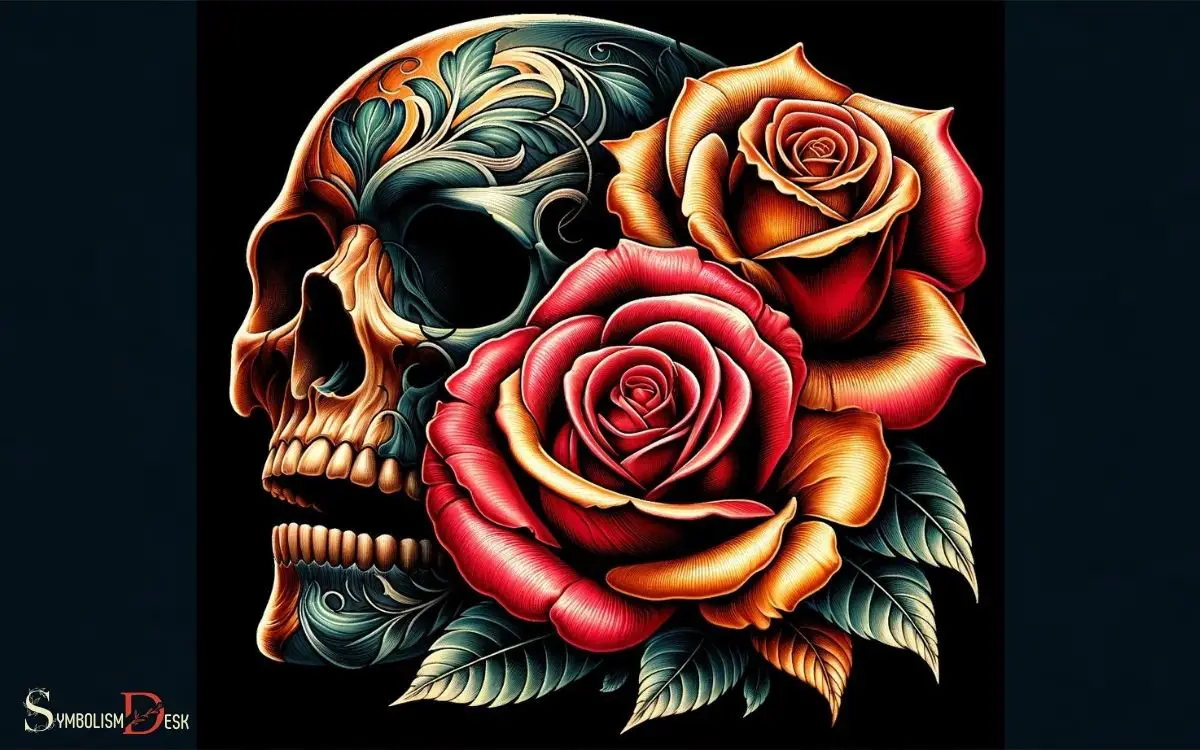What Does a Rose and Skull Tattoo Symbolize? Beauty & Decay!
A rose and skull tattoo symbolizes the juxtaposition of life and death, beauty and decay, and can represent a deep appreciation for the balance between the ephemeral nature of life and the certainty of death.
It’s a popular design that conveys the wearer’s awareness of their own mortality and the preciousness of life.
The rose is a timeless symbol of beauty, love, and passion, often associated with the vitality of life.
In contrast, the skull is a stark representation of death and the finite nature of human existence. When combined, they create a powerful visual metaphor that speaks to the balance between opposing forces.
The rose and skull tattoo can carry multiple meanings:
- The acceptance of life and death as inseparable.
- A reminder to live life to the fullest, understanding that it is temporary.
- The beauty found within the cycle of life and death.
- A tribute to lost loved ones or the concept of eternal love beyond death.
Embodying life’s fragility and strength, a rose and skull tattoo is a profound emblem of human existence.
A rose and skull tattoo typically signifies the duality of life and death, contrasting the fleeting beauty of a rose with the enduring symbol of the skull.
It’s a reminder of mortality and the transient nature of existence but also celebrates life’s beauty. This design is chosen by individuals who embrace both the joys of life and the inevitability of death.

Key Takeaway
Historical Significance of Rose and Skull Tattoos
The historical significance of rose and skull tattoos can be traced back to various cultures and time periods, each with its own unique symbolism and meaning.
In many ancient cultures, the rose was a symbol of love, beauty, and passion. It was often associated with goddesses and used in religious ceremonies.
On the other hand, the skull has been a potent symbol across different societies, often representing mortality, the afterlife, or a memento mori.
When combined, the rose and skull tattoo can represent the juxtaposition of life and death, beauty and decay. It can symbolize the fleeting nature of life or serve as a reminder to live life to the fullest.
The imagery of roses and skulls in tattoos continues to evolve, with modern interpretations incorporating personal meanings for individuals.
Cultural Interpretations and Symbolism
Rooted in diverse cultural interpretations, the combination of a rose and skull tattoo holds significant symbolism across various societies, encompassing themes of life, death, beauty, and mortality.
- In Mexican culture, the skull, or ‘calavera,’ represents the Day of the Dead, a time to honor deceased loved ones, while the rose symbolizes love and beauty.
- In Japanese tradition, the skull signifies major life events and change, and the rose represents the fleeting nature of life and its beauty.
- Within Western societies, the rose and skull tattoo is often seen as a juxtaposition of life and death, representing the coexistence of beauty and mortality.
This rich tapestry of cultural meanings adds depth and complexity to the rose and skull tattoo, reflecting the diverse perspectives and interpretations from different parts of the world.
Understanding these cultural nuances provides a deeper appreciation for the symbolism within this popular tattoo motif.
Moving forward, exploring the psychological meanings and personal expression will provide a comprehensive understanding of this intriguing tattoo choice.
Psychological Meanings and Personal Expression
Embedded in the complex symbolism of the rose and skull tattoo is a profound opportunity for personal expression, tapping into deep psychological meanings and individual narratives.
For many individuals, the juxtaposition of the delicate rose with the macabre skull represents the duality of life and death, the beauty and the inevitable end.
Psychologically, this tattoo can serve as a reminder of the transient nature of existence, prompting contemplation on mortality and the fleeting nature of time.
It can also symbolize the resilience and strength to endure hardships, as the rose often represents love and beauty, while the skull can signify mortality and the struggle of life.
Furthermore, the personal stories and experiences of individuals can influence the specific meaning of this tattoo, making it a deeply personal form of expression.
Variations in Design and Artistic Representations
Exploring variations in design and artistic representations, individuals often express their unique perspectives through the combination of a rose and skull tattoo, capturing the juxtaposition of life and death in diverse and creative ways.
Some common variations in design and artistic representations include:
- Traditional style: This classic approach often features bold lines, vibrant colors, and a clear distinction between the delicate rose and the ominous skull.
- Realistic interpretation: Some individuals opt for a more lifelike representation, with intricate details that showcase the natural beauty of the rose and the haunting realism of the skull.
- Abstract or symbolic designs: Others may choose to take a more interpretive approach, using abstract shapes or symbolic elements to convey deeper meanings and personal significance.
These variations allow for a wide range of artistic expression, making each rose and skull tattoo truly unique.
Modern Trends and Contemporary Context
In the modern tattooing landscape, artists continue to reinterpret the classic motif of a rose and skull, infusing it with contemporary elements and personal narratives. This evolution has led to a diverse range of designs that reflect the current cultural and artistic influences.
Below is a table showcasing some of the modern trends and contemporary contexts influencing rose and skull tattoos:
| Modern Trends | Contemporary Contexts |
|---|---|
| Minimalist designs | Embracing simplicity and subtlety in tattoo art |
| Watercolor techniques | Incorporating vibrant and abstract elements |
| Geometric patterns | Fusing traditional motifs with modern aesthetics |
| Cultural symbolism | Infusing tattoos with personal heritage and meaning |
| Collaborative pieces | Working with artists from different disciplines for unique interpretations |
These trends and contexts highlight the adaptability and enduring significance of the rose and skull motif in the contemporary tattoo culture.
Conclusion
The rose and skull tattoo symbolizes the juxtaposition of life and death, beauty and decay. Like a thorny rose blooming from the eye sockets of a skull, it represents the balance between love and mortality. In addition, the blue rose tattoo meanings also play a significant role in this juxtaposition. The blue rose, often associated with mystery and the unattainable, adds an element of complexity to the design. It can symbolize the unattainable or the impossible, further emphasizing the contrast between life and death represented by the rose and skull imagery.
From historical roots to modern interpretations, this tattoo continues to captivate and intrigue with its layered meanings and artistic representations. It’s a timeless emblem of the human experience, reminding us that even in darkness, there’s still beauty to be found.






